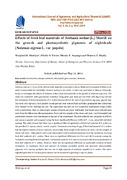| dc.description.abstract | Solanum nigrum L. is one of the African leafy vegetable consumed in Kenya. High cost of inorganic fertilizers has
made it inaccessible by smallholder farmers leading to low yields. A study was conducted at Maseno University,
Kenya to investigate the effects of Sesbania sesban fresh leaf materials on the growth of Solanum nigrum L. The
study was conducted under greenhouse conditions using 3litre pots. Each pot was filled with 2kg of top soil and
five treatments of fresh leaf materials of S. sesban incorporated at the rates of 0g (control), 15g, 30g, 45g and 60g.
Ten seeds of S. nigrum L were planted in each pot and were watered daily until they germinated after which they
were thinned to five seedlings per pot. The experiment was laid out in a completely randomized design (CRD)
with 5 replications. Data on stem length, number of leaves per plant, leaf length, leaf breath were collected each
week from the fifteen day after germination. Fresh and dry weights of the stems and roots, Leaf chlorophyll and
carotenoids contents were determined at the end of the experiment. The data collected was subjected to ANOVA
and means separated and compared using the least significant difference (LSD) at P = 0.05, using SAS statistical
package. The study showed that there was a significant effect of application of fresh leaf material of S. sesban on
the growth of S. nigrum plants, variety: popolo. Treatment consisting of 45g of fresh leaf material of S. sesban
had the highest number of leaves, leaf area, plant height, fresh weight of the shoots and roots, and dry weights of
shoots and roots. Chlorophyll a (chl a) and chlorophyll b (chl b) contents increased in all the treatments receiving
fresh leaf materials of S. sesban. There were no significant differences in Chl a and chl b contents among the
treatments receiving fresh leaf materials. Carotenoids contents of S. nigrum increased with increasing amounts of
fresh leaf material of S. sesban. However, there was no significant difference in carotenoids contents between
treatments. In conclusion fresh leaf material of sesbania promoted growth and increased photosynthetic
pigments of S. nigrum, probably this was due to high amounts of nutrients supplied by S. sesban. The under
exploited potential of S.sesban green manure can be harnessed in growing S. nigrum plants | en_US |

